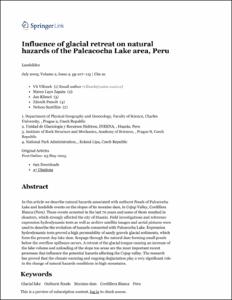Mostrar el registro sencillo del ítem
Influence of glacial retreat on natural hazards of the Palcacocha Lake area, Peru
| dc.contributor.author | Vilímek, Vit | |
| dc.contributor.author | Zapata Luyo, Marco Alfonso | |
| dc.contributor.author | Klimes, Jan | |
| dc.contributor.author | Patzelt, Zdenek | |
| dc.contributor.author | Santillán Portilla, Nelson | |
| dc.coverage.spatial | Cordillera Blanca | |
| dc.date.accessioned | 2019-02-11T16:34:29Z | |
| dc.date.available | 2019-02-11T16:34:29Z | |
| dc.date.issued | 2005 | |
| dc.identifier.citation | Vilímek, V., Zapata Luyo, M. A., Klimes, J. et al. (2018) Influence of glacial retreat on natural hazards of the Palcacocha Lake area, Peru. Landslides, 2, 107-115. doi: https://doi.org/10.1016/j.gloplacha.2007.11.003 | es_PE |
| dc.identifier.issn | ISSN: 1612-510X (Print) 1612-5118 (Online) | es_PE |
| dc.identifier.uri | https://hdl.handle.net/20.500.12543/3338 | |
| dc.description | Original abstract: In this article we describe natural hazards associated with outburst floods of Palcacocha Lake and landslide events on the slopes of its moraine dam, in Cojup Valley, Cordillera Blanca (Peru). These events occurred in the last 70 years and some of them resulted in disasters, which strongly affected the city of Huar´as. Field investigations and reference expression hydrodynamic tests as well as archive satellite images and aerial pictures were used to describe the evolution of hazards connected with Palcacocha Lake. Expression hydrodynamic tests proved a high permeability of sandy gravels glacial sediments, which form the present-day lake dam. Seepage through the natural dam forming small ponds below the overflow spillways occurs. A retreat of the glacial tongue causing an increase of the lake volume and unloading of the slope toe areas are the most important recent processes that influence the potential hazards affecting the Cojup valley. The research has proved that the climate warming and ongoing deglaciation play a very significant. | es_PE |
| dc.description | Artículo en período de embargo | es_PE |
| dc.description.abstract | Describe los peligros naturales asociados con las inundaciones de arroyos del lago Palcacocha y los eventos de deslizamientos de tierra en las laderas de su presa de morrenas, en el valle de Cojup, Cordillera Blanca (Perú). Estos eventos ocurrieron en los últimos 70 años y algunos de ellos resultaron en desastres, que afectaron fuertemente a la ciudad de Huaraz. | es_PE |
| dc.format | application/pdf | es_PE |
| dc.language.iso | eng | es_PE |
| dc.publisher | Springer Berlin Heidelberg | es_PE |
| dc.relation.ispartofseries | Landslides, July 2005, Volume 2, pp 107–115 | es_PE |
| dc.relation.uri | https://link.springer.com/article/10.1007/s10346-005-0052-6 | |
| dc.rights | info:eu-repo/semantics/openAccess | es_PE |
| dc.rights | Attribution-NonCommercial-NoDerivatives 4.0 International | * |
| dc.rights.uri | https://creativecommons.org/licenses/by-nc-nd/4.0/ | * |
| dc.source | Autoridad Nacional del Agua | es_PE |
| dc.source | Repositorio institucional - ANA | es_PE |
| dc.subject | Comportamiento de eventos extremos de origen glaciar y climático | es_PE |
| dc.subject | Gestión de riesgos de desastres en recursos hídricos | es_PE |
| dc.subject | Monitoreo de lagunas y glaciares | es_PE |
| dc.title | Influence of glacial retreat on natural hazards of the Palcacocha Lake area, Peru | es_PE |
| dc.type | info:eu-repo/semantics/article | es_PE |
| dc.identifier.doi | https://doi.org/10.1016/j.gloplacha.2007.11.003 | es_PE |
| dc.coverage.basin | Cuenca Santa |








